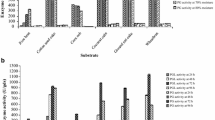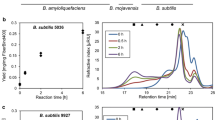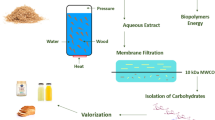Abstract
Potato pulp is a poorly utilized, high-volume co-processing product resulting from industrial potato starch manufacturing. Potato pulp mainly consists of the tuber plant cell wall material and is particularly rich in pectin, notably galactan branched rhamnogalacturonan I type pectin which has previously been shown to exhibit promising properties as dietary fiber. The objective of this study was to solubilize dietary fibers from potato pulp by a one-step minimal treatment procedure and evaluate the prebiotic potential of the fibers. Statistically designed experiments were conducted to investigate the influence of enzyme type, dosage, substrate level, incubation time, and temperature on the enzyme catalyzed solubilization to define the optimal minimal enzyme treatment for maximal fiber solubilization. The result was a method that within 1 min released 75% [weight/weight (w/w)] dry matter from 1% (w/w) potato pulp treated with 1.0% (w/w) [enzyme/substrate (E/S)] pectin lyase from Aspergillus nidulans and 1.0% (w/w) E/S polygalacturonase from Aspergillus aculeatus at pH 6.0 and 60 °C. Molecular size fractionation of the solubilized fibers revealed two major fractions: one fraction rich in galacturonic acid of 10–100 kDa indicating mainly homogalacturonan, and a fraction >100 kDa rich in galactose, presumably mainly made up of β-1,4-galactan chains of rhamnogalacturonan I. When fermented in vitro by microbial communities derived from fecal samples from three healthy human volunteers, both of the solubilized fiber fractions were more bifidogenic than fructo-oligosaccharides (FOS). Notably the fibers having molecular masses of >100 kDa selectively increased the densities of Bifidobacterium spp. and Lactobacillus spp. 2–3 times more than FOS.






Similar content being viewed by others
References
Barkholt V, Jensen AL (1989) Amino-acid analysis—determination of cysteine plus half-cystine in proteins after hydrochloric-acid hydrolysis with a disulfide compound as additive. Anal Biochem 177:318–322
Bauer S, Vasu P, Mort AJ, Somerville CR (2005) Cloning, expression, and characterization of an oligo-xyloglucan reducing end-specific xyloglucanobiohydrolase from Aspergillus nidulans. Carbohydr Res 340:2590–2597
Bauer S, Vasu P, Persson S, Mort AJ, Somerville CR (2006) Development and application of a suite of polysaccharide-degrading enzymes for analyzing plant cell walls. Proc Natl Acad Sci USA 103:11417–11422
Cantarel BL, Coutinho PM, Rancurel C, Bernard T, Lombard V, Henrissat B (2009) The carbohydrate-active enzymes database (CAZy): an expert resource for glycogenomics. Nucleic Acids Res 37:D233–D238. http://www.cazy.org/b.html. Accessed 27 September 2010
Delroisse JM, Boulvin AL, Parmentier I, Dauphin RD, Vandenbol M, Portetelle D (2008) Quantification of Bifidobacterium spp. and Lactobacillus spp. in rat fecal samples by real-time PCR. Microbiol Res 163:663–670
Denman SE, McSweeney CS (2006) Development of a real-time PCR assay for monitoring anaerobic fungal and cellulolytic bacterial populations within the rumen. FEMS Microbiol Ecol 58:572–582
Guo X, **a X, Tang R, Zhou J, Zhao H, Wang K (2008) Development of a real-time PCR method for Firmicutes and Bacteroidetes in faeces and its application to quantify intestinal population of obese and lean pigs. Lett Appl Microbiol 47:367–373
Heilig HGHJ, Zoetendal EG, Vaughan EE, Marteau P, Akkermans ADL, de Vos WM (2002) Molecular diversity of Lactobacillus spp. and other lactic acid bacteria in the human intestine as determined by specific amplification of 16 S ribosomal DNA. Appl Environ Microbiol 68:114–123
Ishii S (1981) Isolation and characterization of cell-wall pectic substances from potato-tuber. Phytochemistry 20:2329–2333
Ishii S (1982) Enzymatic extraction and linkage analysis of pectic polysaccharides from onion. Phytochemistry 21:778–780
Kleerebezem M, Vaughan EE (2009) Probiotic and gut Lactobacilli and Bifidobacteria: molecular approaches to study diversity and activity. Annu Rev Microbiol 63:269–290
Lærke HN, Meyer AS, Kaack KV, Larsen T (2007) Soluble fiber extracted from potato pulp is highly fermentable but has no effect on risk markers of diabetes and cardiovascular disease in Goto-Kakizaki rats. Nutr Res 27:152–160
Leser TD, Lindecrona RH, Jensen TK, Jensen BB, Moller K (2000) Changes in bacterial community structure in the colon of pigs fed different experimental diets and after infection with Brachyspira hyodysenteriae. Appl Environ Microbiol 66:3290–3296
Lever M (1972) New reaction for colorimetric determination of carbohydrates. Anal Biochem 47:273–279
Lever M (1977) Carbohydrate determination with 4-hydroxybenzoic acid hydrazide (Pahbah)—effect of bismuth on reaction. Anal Biochem 81:21–27
Limberg G, Korner R, Buchholt HC, Christensen TMIE, Roepstorff P, Mikkelsen JD (2000) Analysis of pectin structure part 1—analysis of different de-esterification mechanisms for pectin by enzymatic fingerprinting using endopectin lyase and endopolygalacturonase II from A. niger. Carbohydr Res 327:293–307
Meyer AS, Dam BR, Laerke HN (2009) Enzymatic solubilization of a pectinaceous dietary fiber fraction from potato pulp: optimization of the fiber extraction process. Biochem Eng J 43:106–112
Olano-Martin E, Gibson GR, Rastall RA (2002) Comparison of the in vitro bifidogenic properties of pectins and pectic-oligosaccharides. J Appl Microbiol 93:505–511
Olesen M, Gudmand-Hoyer E, Norsker M, Kofod L, Adler-Nissen J (1998) Fermentability of an enzymatically modified solubilised potato polysaccharide (SPP). Eur J Clin Nutr 52:110–114
Palframan RJ, Gibson GR, Rastall RA (2002) Effect of pH and dose on the growth of gut bacteria on prebiotic carbohydrates in vitro. Anaerobe 8:287–292
Rasmussen LE, Meyer AS (2010) Size exclusion chromatography for the quantitative profiling of the enzyme-catalyzed hydrolysis of xylo-oligosaccharides. J Agric Food Chem 58:762–769
Rossi M, Corradini C, Amaretti A, Nicolini M, Pompei A, Zanoni S, Matteuzzi D (2005) Fermentation of fructooligosaccharides and inulin by bifidobacteria: a comparative study of pure and fecal cultures. Appl Environ Microbiol 71:6150–6158
Rycroft CE, Jones MR, Gibson GR, Rastall RA (2001) A comparative in vitro evaluation of the fermentation properties of prebiotic oligosaccharides. J Appl Microbiol 91:878–887
Sanz ML, Gibson GR, Rastall RA (2005) Influence of disaccharide structure on prebiotic selectivity in vitro. J Agric Food Chem 53:5192–5199
Sokol H, Seksik P, Furet JP, Firmesse O, Nion-Larmurier L, Beaugerie L, Cosnes J, Corthier G, Marteau P, Dore J (2009) Low counts of Faecalibacterium prausnitzii in colitis microbiota. Inflamm Bowel Dis 15:1183–1189
Stratton J, Chiruvolu V, Meagher M (1998) High cell-density fermentation. In: Pichia protocols, 103rd edn. Humana Press, Totowa, NJ, pp 107–120
Thomassen LV, Meyer AS (2010) Statistically designed optimisation of enzyme catalysed starch removal from potato pulp. Enzyme Microb Technol 46:297–303
Turnbaugh PJ, Ley RE, Mahowald MA, Magrini V, Mardis ER, Gordon JI (2006) An obesity-associated gut microbiome with increased capacity for energy harvest. Nature 444:1027–1031
Van den Broek LAM, denAantrekker ED, Voragen AGJ, Beldman G, Vincken JP (1997) Pectin lyase is a key enzyme in the maceration of potato tuber. J Sci Food Agric 75:167–172
Van Laere KMJ, Hartemink R, Bosveld M, Schols HA, Voragen AGJ (2000) Fermentation of plant cell wall derived polysaccharides and their corresponding oligosaccharides by intestinal bacteria. J Agric Food Chem 48:1644–1652
Walter J, Tannock GW, Tilsala-Timisjarvi A, Rodtong S, Loach DM, Munro K, Alatossava T (2000) Detection and identification of gastrointestinal Lactobacillus species by using denaturing gradient gel electrophoresis and species-specific PCR primers. Appl Environ Microbiol 66:297–303
Acknowledgments
We thank the employees at Gums and Systems Development, Danisco (Brabrand, Denmark) for the help and supervision during upscaling the dietary fiber release procedure. The authors would like to acknowledge Fungal Genetic Stock Center for the Pichia pastoris clone expressing the pectin lyase gene AN2569.2, the polygalacturonase gene AN4372.2, and the pectin methyl esterase gene AN3390.2 and Lyckeby Stärkelsen (Kristianstad, Sweden) for supplying the potato pulp. This study was supported by the Danish Strategic Research Council’s Committee on Food and Health (FøSu, Center for Biological Production of Dietary Fibres and Prebiotics, no. 2101-06-0067). Financial support from the FOOD Denmark Graduate School, Center for Advanced Food Studies, Denmark, is also acknowledged.
Author information
Authors and Affiliations
Corresponding author
Rights and permissions
About this article
Cite this article
Thomassen, L.V., Vigsnæs, L.K., Licht, T.R. et al. Maximal release of highly bifidogenic soluble dietary fibers from industrial potato pulp by minimal enzymatic treatment. Appl Microbiol Biotechnol 90, 873–884 (2011). https://doi.org/10.1007/s00253-011-3092-y
Received:
Revised:
Accepted:
Published:
Issue Date:
DOI: https://doi.org/10.1007/s00253-011-3092-y




